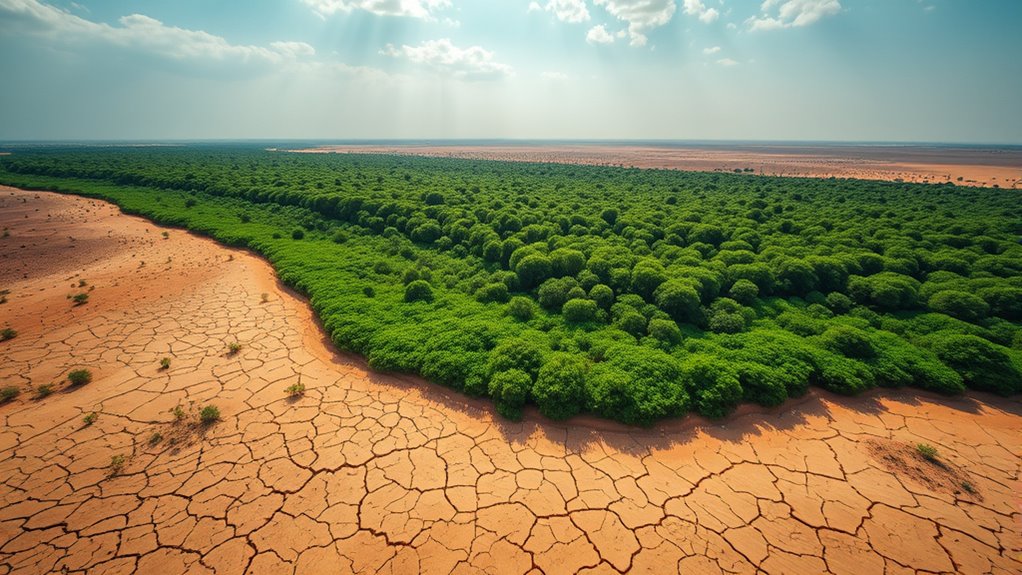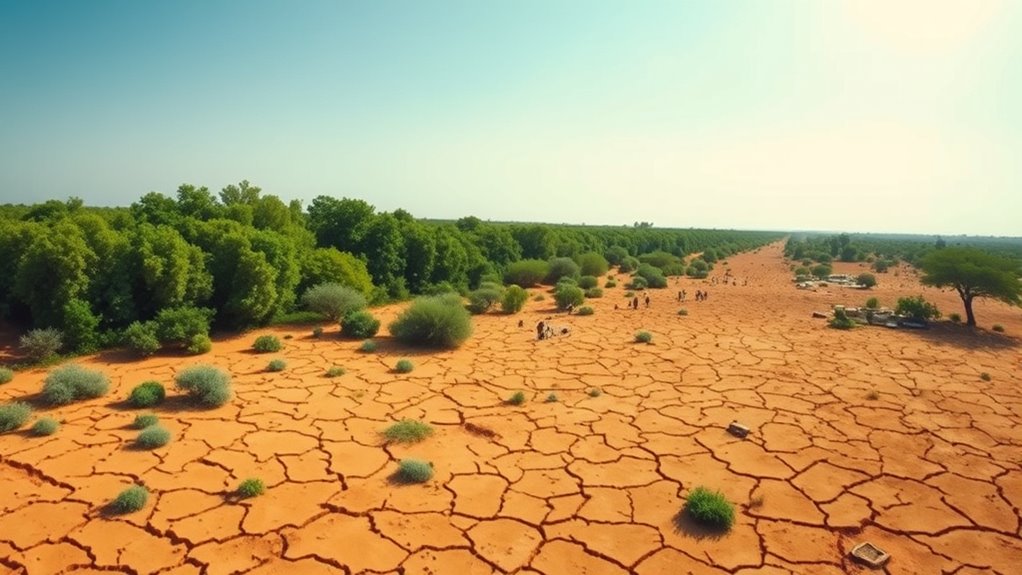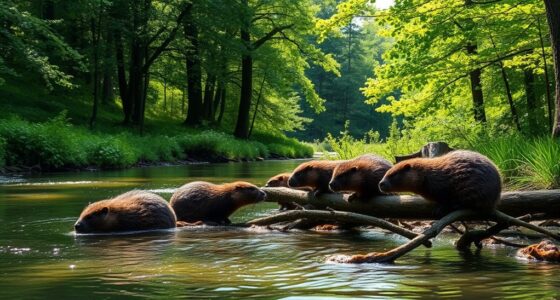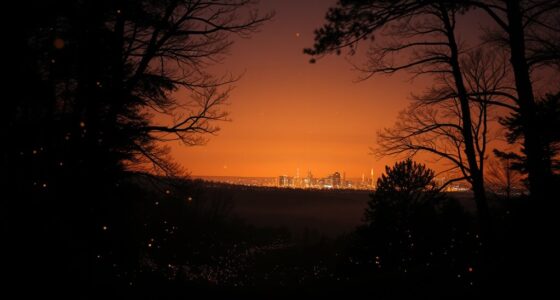The Great Green Wall is Africa’s ambitious project to fight desertification by planting a continuous belt of trees and vegetation across the Sahel region. It aims to stop the desert sands from spreading, restore degraded lands, and support local communities through sustainable farming practices and ecosystem rehabilitation. By creating natural barriers and microclimates, it prevents land degradation and boosts resilience against climate change. Want to discover how this bold effort is transforming Africa’s landscape? Keep exploring to learn more.
Key Takeaways
- The Great Green Wall is an 8,000 km initiative across Africa’s Sahel to combat desertification and restore degraded land.
- It combines ecosystem restoration, sustainable agriculture, and community participation to create a resilient natural barrier.
- The project uses trees and vegetation as windbreaks, stabilizing soil and trapping moisture to prevent land degradation.
- Monitoring technologies and collaborative efforts ensure effective implementation and long-term environmental and social benefits.
- The initiative aims to support local livelihoods, combat climate change, and reverse environmental damage in Africa.

Have you ever wondered how Africa is fighting desertification and restoring its environment? The answer lies in an ambitious project called the Great Green Wall. Spanning across 8,000 kilometers of the Sahel region, this massive initiative aims to create a living barrier of trees and vegetation that can halt the advance of desert sands. As you explore this project, you’ll see how it combines sustainable agriculture and desertification prevention to transform degraded lands into productive, resilient landscapes. The goal isn’t just to plant trees; it’s to restore ecosystems, support local communities, and combat the harsh realities of climate change.
One of the key strategies behind the Great Green Wall involves promoting sustainable agriculture. Local farmers are encouraged to adopt methods that preserve soil quality and water resources, making their land more productive over time. Techniques like agroforestry, where trees are integrated into crop systems, help improve soil fertility and reduce erosion. This approach not only prevents desertification but also boosts food security for communities that often struggle with droughts and poor harvests. By practicing sustainable agriculture, farmers can regenerate their land, making it more resilient to the encroaching desert and ensuring their livelihoods for generations to come.
Promoting sustainable agriculture through agroforestry to improve soil, prevent desertification, and secure local food sources.
Desertification prevention is at the heart of this project. The Sahel region faces relentless threats from climate variability, overgrazing, deforestation, and unsustainable land use, all of which accelerate land degradation. The Great Green Wall acts as a natural barrier, stabilizing the soil and reducing wind erosion. Trees and vegetation act as windbreaks, trapping moisture and creating microclimates that support new plant growth. This process gradually transforms barren landscapes into greener, more hospitable areas. It’s a proactive effort to stop desertification in its tracks before it spirals out of control, providing a sustainable solution that benefits both the environment and local communities. Additionally, the use of high-resolution projectors in environmental mapping can help monitor and optimize restoration efforts more effectively.
As you follow the progress of the Great Green Wall, you’ll notice that it’s not just about planting trees; it’s about fostering a movement of local people, governments, and organizations working together. They’re planting hope—hope that through sustainable practices and desertification prevention, Africa can reclaim its land from the brink of desertification. This project exemplifies how strategic environmental intervention, rooted in community engagement and sustainable agriculture, can create lasting change. It’s a bold step towards reversing environmental damage, ensuring that the land remains productive and life-sustaining for future generations.
Frequently Asked Questions
How Is Community Participation Integrated Into the Project?
You’re asking how community participation is incorporated into the project. Through active community engagement, local residents are encouraged to participate in planning and implementation. This approach fosters local empowerment, enabling communities to take ownership of tree planting, land management, and maintenance efforts. By involving local voices and resources, the project guarantees sustainability and relevance, making communities active partners in combating desertification and restoring ecosystems along the green wall.
What Are the Long-Term Economic Benefits for Local Communities?
You’ll see long-term economic benefits as agricultural productivity increases, thanks to restored land and better water management. These improvements create more employment opportunities, helping local communities thrive. With healthier ecosystems, you’ll likely experience a boost in crop yields and income. This sustainable growth supports resilience against climate change and fosters economic stability, ensuring communities can prosper for generations to come.
How Is the Project Funded and Sustained Financially?
Funding sources for this project are like a patchwork quilt, made from various contributions. You’ll find governments, international organizations, NGOs, and private donors all pitching in. To guarantee financial sustainability, ongoing support and collaboration are essential, with local communities also playing a key role. This diverse backing helps keep the project alive and thriving, making sure the Green Wall continues to grow and protect the land for years to come.
What Measures Are Taken to Prevent Ecological Imbalance?
You focus on preventing ecological imbalance by implementing soil restoration techniques that improve soil health and boost plant growth. You also prioritize biodiversity preservation, guaranteeing native species thrive and ecosystems remain balanced. By monitoring environmental impacts regularly and involving local communities, you help sustain these efforts. These measures work together to maintain ecological stability, support resilience against desertification, and ensure the project’s long-term success across the region.
How Does the Project Address Climate Change Resilience?
You focus on boosting climate change resilience by implementing soil conservation techniques and controlling desertification. These efforts help maintain healthy ecosystems, prevent land degradation, and reduce vulnerability to extreme weather. By planting trees and restoring degraded land, you enhance moisture retention and biodiversity. This proactive approach strengthens communities against climate impacts, ensuring sustainable livelihoods and ecological stability in vulnerable regions, making the environment more resilient to the changing climate.
Conclusion
So, as you see, the Great Green Wall isn’t just about planting trees; it’s a bold hope for Africa’s future. Some say it might not fully stop desertification, but even if it only slows it down, that’s a win. Think of it as a giant, hopeful bandage for a wounded land. You can’t control everything, but your efforts make a difference. And in this case, that difference could change countless lives.









